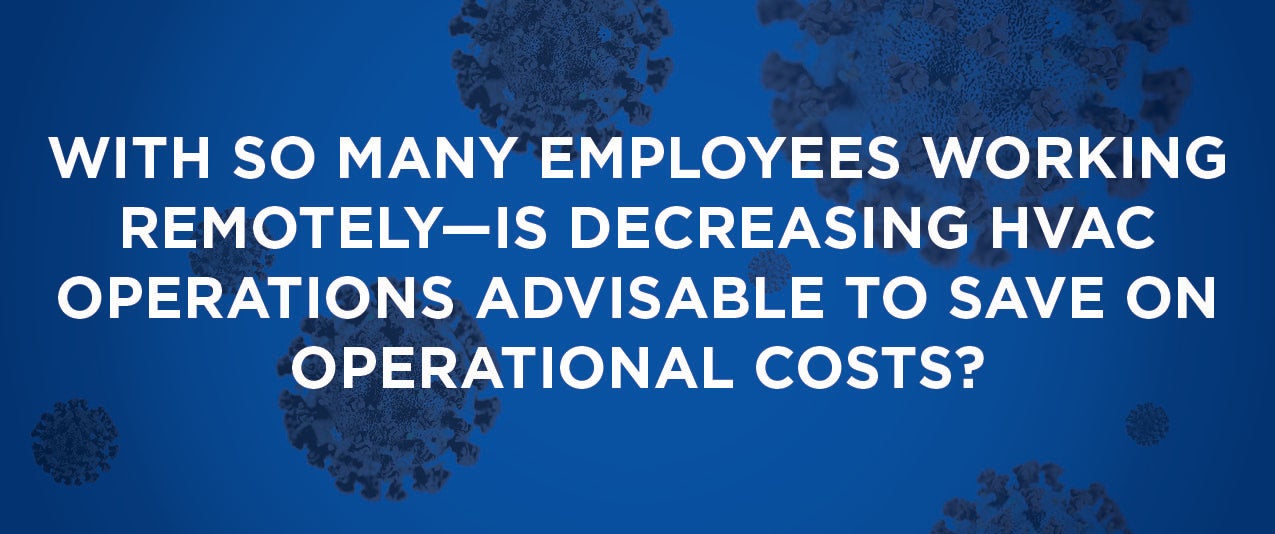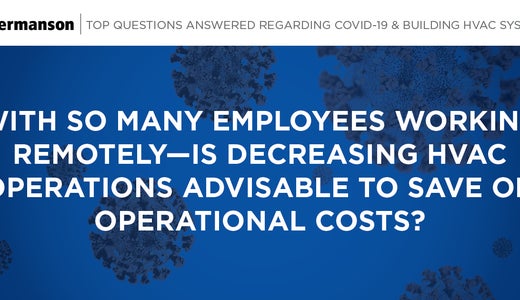
As businesses look at the long-term economic impacts of the COVID-19 outbreak, many are turning to short-term reductions in operational costs. Today’s response from Hermanson’s TAB/Commissioning/Controls Manager Brad Sharp, CHC, with assistance from Hermanson Senior Engineer, Pedro Alicea, again offers guidance based on industry recognized standards and best practices set forth by ASHRAE, NIH, FGI, CDC, and OSHA.
With the current economic volatility, many building operators may be looking for ways to reduce operational costs. If a building is unoccupied, turning off the HVAC equipment may seem like a cost-effective option. Most HVAC systems are equipped with an Unoccupied Mode that is used when buildings are not in use. However, the following should be considered before making any decisions:
Has there been an instance of confirmed exposure to or infection of COVID-19?
NIH is currently reporting that the COVID-19 virus can remain viable on surfaces for up to four days, so before making any changes to HVAC operations, following CDC protocol for exposure is recommended.
The CDC dictates that upon exposure, the area used by ill or exposed persons should be closed off. Outside air should be increased to enhance air circulation in the area for a recommended minimum of 24 hours, if possible. According to ASHRAE Standard 62.1 and FGI Commissioning Guidelines, flushing the building with as much outside air as possible is recommended -- this is best completed when the energy impact is at its lowest (such as when the outdoor temperature is 50° or greater).
After the ventilation period, begin cleaning and disinfection to minimize potential exposure to respiratory droplets (see Top Questions, Part 1 for information on proper PPE). It is recommended that air filters for the HVAC system be replaced as part of the cleaning and disinfection process.
What factors should be considered before making changes to the HVAC system?
After introduction of increased outside air to building and recommended cleaning and disinfection in areas of exposure, an HVAC system may be put on Unoccupied Mode. However, it is important that humidity and temperature levels be controlled. Should an area become too humid, mold may develop (ASHRAE Limiting Indoor Mold and Dampness in Buildings, Page 9-10). Freezing temperatures could cause water pipes to burst. Therefore, Unoccupied Modes that keep areas from becoming too humid, freezing or too hot can be used to reduce HVAC operational costs until the areas are once again occupied.
If your HVAC system is equipped with a DDC, programming code changes can be made to achieve the desired balance between operational savings and optimal outside air utilization. Contact your building’s HVAC preventative maintenance contractor for detailed information specific to your building’s equipment and operations.
-----------------------------
The responses offered in this post are based on findings of industry recognized standards and best practices developed by ASHRAE, NAFA, CDC, OSHA and FGI. They are offered as guidelines and do not account for the specifics of any building or its mechanical systems. For specific information as to a given building or system, please contact Hermanson or a licensed mechanical engineer. Any actions taken based on the responses given are the sole responsibility of the party taking such actions.


